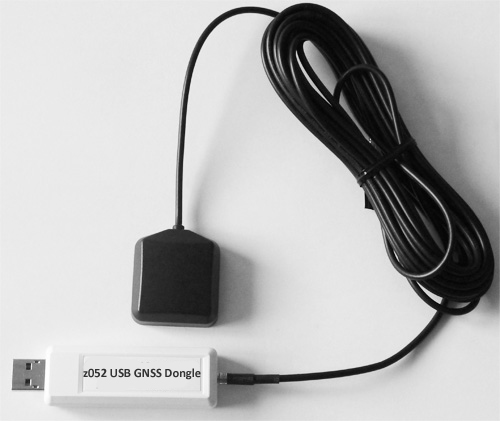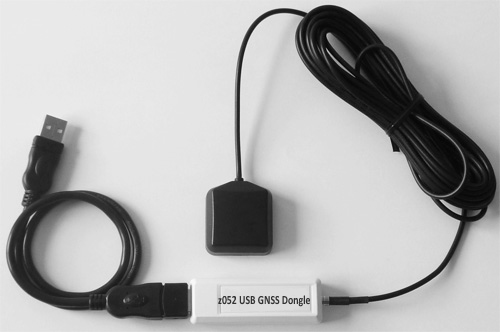z052 Timing and Navigation Module

The Pulse Per Second (PPS) is an electrical signal that very precisely indicates the start of a second. The z052 GNSS chipset delivers the PPS signal with the accuracy ± 20 nanoseconds (at chipset level).
The z052 USB dongle provides a GNSS receiver from an USB port and a PPS timing output. The z052 unit is based on a GNSS receiver from u-blox with 72-channel whose 32-channel continuous tracking and high sensitivity (tracking -167dBm GPS & Glonass).
This dongle receives and tracks multiple GNSS systems: GPS, Galileo, Glonass and BeiDou. Owing to the dual-frequency RF front-end architecture, either Glonass or BeiDou can be processed concurrently with GPS and Galileo signals providing reception of three GNSS systems according to the permissible combinations shown below (* = enabled):
| GPS | Galileo | Glonass | BeiDou |
|---|---|---|---|
| * | * | - | - |
| * | * | * | - |
| * | * | - | * |
| * | - | * | - |
| * | - | - | -* |
| - | * | * | - |
| - | * | - | * |
| - | - | * | * |
Note #1: the augmentation systems SBAS and QZSS can be enabled only if GPS operation is configured.
Note #2: The z052 USB dongle is configured by default with GPS, Galileo and Glonass.
With its higher sensitivity, performance and faster startup times, the z052 module is a complete GNSS receiver that generates position fixes with high accuracy in extremely challenging environments and under poor signal conditions (down to -167 dBm), velocity and time data with leading edge acquisition times. In addition, the GNSS receiver provides a configurable 1 PPS synchronized to GPS/UTC, typically within 20 nanoseconds (one sigma) at chipset level and an update rate up to 4 Hz.
The z052 dongle optionally supports Satellite-Based Augmentation System (SBAS), including the U.S. Wide Area Augmentation System (WAAS), the European Geostationary Overlay Service (EGNOS), MSAS in Japan and GAGAN in India. Assisted GNSS (A-GNSS) is also supported.
When the z052 USB dongle is connected to your equipment (desktop, laptop, netbook, UMPC …), a virtual serial port is available after installation of the driver by the operating system – for example: USB Serial Port (Com x).
For most of the operating systems two types of driver are available: Virtual COM Port (VCP) drivers and direct (D2XX) drivers.
- The VCP driver emulates a standard PC serial port such that the USB device may be communicated with as a standard RS232 device. Virtual COM port (VCP) drivers cause the USB device to appear as an additional COM port available to the PC. Application software can access the USB device in the same way as it would access a standard COM port.
- The D2XX driver allows direct access to the USB device via a DLL interface. Application software can access the USB device through a series of DLL function calls.
VCP drivers currently supported:
- Windows 7, Windows Server 2008 R2 and Windows 8, 8.1, Windows server 2012 R2, Windows Server 2016 and Windows 10.
- Linux (VCP driver is integrated in the kernel)
- Mac OS X 10.3 to 10.8
- Mac OS X 10.9 and above
- Windows CE 4.2-5.2: includes the following versions of Windows CE 4.2-5.2 based operating systems: Windows Mobile 2003, Windows Mobile 2003 SE, Windows Mobile 5, Windows Mobile 6, Windows Mobile 6.1, Windows Mobile 6.5
- Windows CE 6.0/7.0
- Windows CE 2013
D2XX direct drivers currently supported:
- Windows 7, Windows Server 2008 R2 and Windows 8, 8.1, Windows server 2012 R2, Windows Server 2016 and Windows 10.
- Windows RT (x86-32 & ARM)
- Linux
- Mac OS X 10.4 Tiger or later
- Windows CE 4.2-5.2: includes the following versions of Windows CE 4.2-5.2 based operating systems: Windows Mobile 2003, Windows Mobile 2003 SE, Windows Mobile 5, Windows Mobile 6, Windows Mobile 6.1, Windows Mobile 6.5
- Windows CE 6.0/7.0
- Windows CE 2013
- Android (Java D2XX)
The USB dongle contains a USB to serial UART interface and the PPS signal provided by the GNSS chipset is connected internally to pin 8 (CTS). So, the PPS signal delivered by the USB dongle is available by using the CTS signal on the virtual com port used.
| Applications | Benefits |
|---|---|
| Timing and Synchronization | Ultra compact GNSS receiver with high accuracy by using the PPS signal for timing applications |
| Vehicle Navigation Automatic Vehicle Location | Accurate GNSS positioning within 2.5 meters |
Use with External GNSS Antenna |
Key Features
- u-blox NEO-M8T concurrent GNSS timing chipset with internal Flash memory that allows future firmware updates / Raw data available in order to achieve RTK centimeter accuracy (e.g. post-processing by using RTKLIB)
- Concurrent reception of GPS/QZSS, GLONASS, BeiDou and Galileo
- Market leading acquisition and tracking sensitivity
- Optimized accuracy and availability with survey-in and single-satellite timing
- Maximized reliability with integrity monitoring and alarms
- Assisted GNSS (AssistNow Online and Offline from u-blox, AssistNow Autonomous)
- Satellite-Based Augmentation System (SBAS): WAAS (US), EGNOS (Europe), MSAS (Japan) and GAGAN (India) and QZSS for the Pacific region covering Japan and Australia
- Max navigation update rate: 4 Hz (GPS & Glonass, GPS & Beidou), 10 Hz (GPS, Glonass, BeiDou, Galileo)
- Protocols: NMEA, UBX binary, RTCM
- PPS timing output
- Use of an external active GNSS antenna
- Compact Design with a size of a USB key (USB 2.0 Interface)
- Suitable for Laptop, Desktop, Mobile Device, UMPC, Eee PC, Notebooks and Netbooks
- RoHS Compliance
GNSS Performance Specifications
GNSS performance statistics are clear view, stationary. Sensitivity based on signals measured at the antenna.
| Parameter | Value |
|---|---|
| Receiver type | 72-channel u-blox M8 engine GPS L1 C/A, QZSS L1C/A, QZSS L1SAIF, GLONASS L1OF, BeiDou B1, Galileo E1-B/C SBAS: WAAS (US), EGNOS (Europe), MSAS (Japan), GAGAN (India) |
| Navigation Update Rate | Concurrent GNSS: up to 4 Hz, 1 Hz (default) GPS, Glonass, BeiDou, Galileo: up to 10 Hz |
| Position Accuracy | 2.5 m CEP (Autonomous) 2.0 m (SBAS) |
| Acquisition time Cold starts: Aided cold starts: | GPS & Glonass / GPS & BeiDou 25 s / 28 s 2 s / 2 s |
| Sensitivity Tracking & Navigation: Cold start (aided): Cold start (autonomous): Reacquisition: | GPS & Glonass / GPS & BeiDou -167 dBm / -166 dBm -157 dBm / -157 dBm -148 dBm / -148 dBm -160 dBm / -160 dBm |
| Anti jamming | Active CW detection and removal; on-board SAW band pass filter |
| Memory | Internal SQI flash for firmware update |
| Timing Accuracy | ≤ 20 ns Clear Sky ≤ 500 ns Indoor |
| Time Pulse Frequency | 0.25 Hz – 10 MHz, 1 Hz (default) |
| Time-pulse jitter | ±11 ns |
| Integrity reports | RAIM active, phase uncertainty Time-pulse rate/duty-cycle |
| Protocols | NMEA, UBX binary, RTCM |
| Operational limits | Dynamics ≤4g Altitude 50,000 m Velocity 500 m/s |
| Operating Temperature | -40°C to +85°C |
Ordering Information
| Reference | Description |
|---|---|
| z052-USB | z052 USB GNSS Dongle with PPS Contains: z052 USB GNSS Dongle with PPS + USB Extension Cable + GNSS patch antenna (5m cable) + CD-ROM (Software & Documentation). |
| z052-STK | z052 Starter Kit = z052-USB + TSS-P for z052 Software Contains: z052 USB GNSS Dongle with PPS + USB Extension Cable + GNSS patch antenna (5m cable) + CD-ROM (Software & Documentation) with one license of Windows TSS-P for z052 software (Time Service Software) for the update of the PC clock with 1ms guaranteed accuracy. |
 |  |
Specifications are subject to change without notice.
